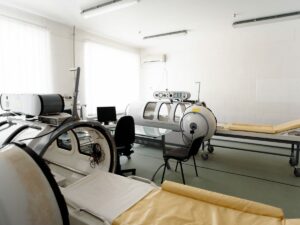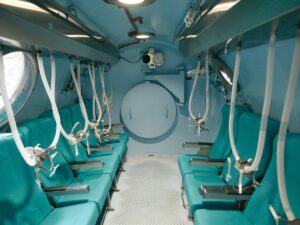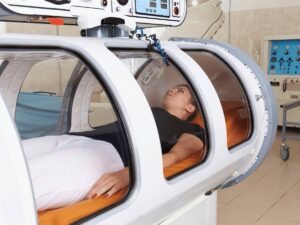Are low or high pressure chambers more effective for therapeutic and operational needs? These technologies differ significantly in their applications and benefits.
With extensive experience in hyperbaric chamber technology, I provide insights grounded in the latest research and real-world applications.
Low pressure chambers typically simulate higher altitudes or outer space conditions while high pressure chambers are used to mimic deep-sea or underground environments.
In this guide, you’ll gain insights into the functionalities of both low and high-pressure chambers, explore their advantages and constraints, and receive advice on selecting the appropriate type for your specific needs.
Discover the best chamber for you!
1. The Basics of Pressure Chambers
Pressure chambers, often referred to as hyperbaric chambers, play a crucial role in various fields by artificially creating pressure conditions. Pressure chambers are specialized devices where the air pressure can be controlled and significantly altered from the atmospheric pressure we normally experience.
In their simplest form, pressure chambers are sealed enclosures that can have the internal pressure adjusted either above or below ambient pressure. This versatility allows them to be tailored to specific needs, whether helping athletes recover faster from muscle injuries or assisting divers in acclimatizing to underwater pressures.

2. Low Pressure Chambers
Low pressure chambers are designed to operate at pressures slightly above atmospheric levels, providing a controlled environment for various treatments and processes. Here are some key benefits of using low pressure chambers:
Enhanced Recovery From Physical Exertion
Athletes find that these chambers significantly reduce recovery time by facilitating quicker muscle recuperation. For example, football players often use low pressure chambers post-game to alleviate muscle soreness and enhance their recovery process.
Improved Treatment of Altitude Sickness
These Oxygen-ark chambers can mimic lower altitude conditions, which is beneficial for acclimatization or treating altitude-related illnesses. And the best part is, they do so in a controlled, safe environment.
Support for Lighter Medical Conditions
For conditions that require a subtle approach, such as fibromyalgia or chronic fatigue syndrome, low pressure chambers, provide a gentle yet effective treatment option. They help enhance oxygen flow and aid in overall body relaxation without the intensity required by high pressure treatments.
A recent study in National Center for Biotechnologgy Information, highlights the effectiveness of using low pressure chamber combined with physical exercise in women with fibromyalgia. It was found that this approach not only improves the pressure pain threshold but also enhances endurance, functional capacity, and physical performance.
Accessibility and Ease of Use
Low pressure chambers are more than just accessible; they’re a breeze to use. Their simpler setup and operation make them ideal for various settings, from small clinics to athletic facilities. With these chambers, providing care becomes less about technical complications and more about focusing on recovery and wellness, making it easier for you to integrate them into your care routine, no matter the size of your facility.
3. High Pressure Chambers
High pressure chambers operate at significantly higher pressures compared to low pressure chambers, enabling more intensive treatments and environmental simulations. Here are some key benefits:
Accelerated Wound Healing
High pressure chambers, like what Oxygen-ark offers, increase oxygen saturation in the body, speeding up the healing process for severe wounds and post-surgical recoveries. But wait, there’s more—this advanced technology also significantly reduces infection rates and promotes faster tissue regeneration.
Enhanced Ability To Fight Infections
These chambers deliver high concentrations of oxygen to body tissues, which is crucial for enhancing the body’s ability to fight against infections more effectively. High oxygen levels can inhibit anaerobic bacteria and boost the immune system’s response. For instance, individuals suffering from osteomyelitis have experienced improved outcomes when their treatment included sessions in a high pressure chamber.
Treatment of Serious Diving Conditions
High pressure chambers are indispensable for treating decompression sickness—a common and potentially life-threatening condition faced by deep-sea divers. These chambers can simulate different depths, providing a controlled environment to safely prepare and treat divers for and from deep-water exposures.
Support for Severe Cases of Carbon Monoxide Poisoning
High pressure chambers offer one of the most effective treatments available for severe carbon monoxide poisoning, quickly displacing the toxic gas from hemoglobin and restoring normal oxygen levels to critical tissues and organs.
Here’s a table summarizing the application of high pressure chambers in treating severe cases of carbon monoxide poisoning:
| Treatment Method |
Description |
Benefit |
| Enhanced Oxygen Delivery |
The increased pressure allows for a higher concentration of oxygen in the blood. |
Accelerates the delivery of oxygen to vital organs and tissues, aiding recovery. |
| Severe CO Poisoning Treatment |
Specifically effective in severe cases where traditional oxygen therapy may not suffice. |
Provides a crucial treatment option that can significantly improve patient outcomes. |
| Speed of Action |
High pressure oxygen therapy works faster than normal pressure oxygen therapy. |
Offers a rapid response in critical poisoning situations, reducing potential long-term damage. |
| Medical Recommendation |
Recommended for severe carbon monoxide poisoning by health professionals. |
Supported by medical research and practice, confirming its effectiveness. |
4. Comparative Analysis: Low vs High Pressure Chambers
As we transition from discussing individual aspects of low and high pressure chambers, it’s important to delve into their comparative features and the unique advantages each offers in various settings. Here are the key insights and distinctions between low and high pressure chambers:
Design and Capability
- Low Pressure Chambers: These chambers are designed to simulate environments up to a certain altitude, primarily used for training and acclimatization purposes. They can mimic conditions found at high altitudes, helping individuals prepare for or recover from exposure to such environments.
- High Pressure Chambers: High-pressure chambers, on the other hand, are built to provide therapeutic benefits by delivering 100% oxygen at pressures greater than sea level. This process helps accelerate the body’s natural healing processes, especially beneficial for patients with certain medical conditions.

Use Cases
- Low Pressure Chambers: These chambers are commonly used in aerospace and sports, where simulating high-altitude conditions is necessary for training or research. Athletes use these chambers to improve performance and endurance by training their bodies to utilize oxygen more efficiently which is amazing, isn’t it?
- High Pressure Chambers: These chambers play a critical role in medical treatments, such as treating decompression sickness, serious infections, and wounds that won’t heal as a result of diabetes or radiation injury. Their ability to increase oxygen supply to tissues makes them invaluable in hyperbaric medicine.
Safety and Training Requirements
- Low Pressure Chambers: Operating low-pressure chambers requires basic training, primarily focusing on monitoring and adjusting the chamber’s environment. The risks associated with their use are relatively low, making them safer and easier to manage.
- High Pressure Chambers: High-pressure chambers require operators to undergo specialized training due to the potential risks of handling high-pressure oxygen environments. Safety protocols are strict, emphasizing the importance of well-trained personnel to manage these chambers.

Technological Advancements
- Low Pressure Chambers: Technological advancements in low-pressure chambers focus on improving the simulation of high-altitude conditions with greater accuracy and control. Innovations aim to make these simulations more realistic, enhancing the training and research applications.
- High Pressure Chambers: In high-pressure chambers, advancements are geared towards enhancing safety features, treatment efficacy, and patient comfort. Innovations include better pressure control, more efficient oxygen delivery systems, and improved patient monitoring capabilities.

5. 3 Tips for Choosing the Right Pressure Chamber for Your Needs
After exploring the main differences between high and low-pressure chambers, it’s clear that each serves unique purposes across various fields. Choosing the right one depends on your specific needs, whether they’re for medical treatment, research, or training. Here are some essential tips to help you make the best choice:
#1 Assess Your Intended Use
Determine the primary function of the chamber. For facilities focusing on athletic training or altitude acclimatization, a low pressure chamber, which typically operates at pressures of 1.3 to 1.5 ATA (Atmospheres Absolute), suffices. For medical treatments like severe infections or decompression sickness, a high pressure chamber is necessary, which can operate at pressures of 2.0 to 3.0 ATA. How awesome is that?
#2 Evaluate Cost Implications
Be aware of the cost differences. Low pressure chambers typically range from $75,000 to $150,000, while high pressure chambers can cost from $100,000 to over $300,000, not including installation and operational costs. Consider your budget and the potential return on investment, especially in high-utilization scenarios.
#3 Facility Space
Low Pressure Chambers are relatively compact and can often fit within a standard room size without extensive modifications. A typical low pressure chamber might require a footprint of about 8×6 feet. High Pressure Chambers require more substantial space. A common size can be upwards of 12 feet in diameter and may require additional space for associated machinery and safety equipment.
Dive Deeper Into Our Resources
For some insightful reads, we’ve curated a list of recommended articles just for you:
Still haven’t found what you’re looking for? Don’t hesitate to contact us. We’re available around the clock to assist you.
Conclusion
Choosing between low and high pressure chambers hinges on understanding their distinct applications and benefits as outlined in this guide. We’ve explored how each type caters to different needs, from mild therapeutic uses to intense medical treatments.
If your business is considering the integration of Hyperbaric Chambers, Oxygen-ark offers expert guidance to ensure you make the best choice. For more detailed information tailored to your specific requirements, please contact us.




